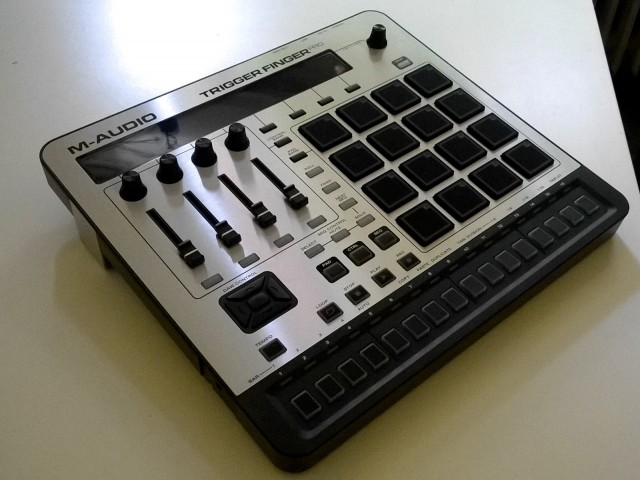M-Audio’s first Trigger Finger might be the most ubiquitous controller in laptop music. Pads, faders, knobs. It was almost a stupidly simple equation, but it caught on.
The Trigger Finger Pro is something different. It takes on three roles:
1. It’s a controller for included software. If you want hands-on control of software right away, M-Audio has bundled tools that integrate directly with the controller: there’s Arsenal, a kind of drum sampler-style tool M-Audio calls a “production hub,” AIR Drums, a dedicated drum module, and Hybrid 3, a very lovely synth, plus loads of sample content. But what sets Trigger Finger Pro apart from things like Ableton’s Push, Native Instruments’ Maschine, and Arturia’s SparkLE is that the controller isn’t just for that software.
2. It’s a flexible controller for anything. Each bank and each pad can control something different, if you like. Every fader, button, and pad can be configured to work with software or hardware of your choice. You can route MIDI to the external device alone, to the computer alone, or to both. And you can do all of this while tethered to the computer or (if you get a power adapter) standalone. Also, unlike past M-Audio hardware, all the editing is available right from the front panel – no editor software needed. The only bad news, really, is that you lose the dedicated eight knobs on the original Trigger Finger.
3. It’s a step sequencer. It’s actually a reasonably advanced step sequencer. You can play on the pads, or use x0x-style buttons on the bottom, as on the original Roland TB-303. (And, notably, something absent from the AIRA follow-up to the 303 original.) Because it’s able to work in standalone mode, this is fairly powerful.
And as both a controller and a step sequencer, if you connect it to a power adapter, you don’t need the computer connected at all. It functions as true standalone hardware, which Push, Maschine, SparkLE – and the original Trigger Finger Pro – cannot.
It’s all something that’s easiest seen in action. M-Audio quietly released some videos to do just that, showing the basics of each of these features.
The user interface walkthrough is essential, as otherwise it can be unclear (even from the Quick Start documentation in the box) just how things work. You can see how Arsenal integrated out of the box with the pads,
The control setup video shows how the controller layouts work. What’s worth noticing: this is a whole lot more flexible than what Push or Maschine offer, and you’re doing all the editing right on the front panel – no editing app needed.
But the video you really want to watch is the sequencing video, as it’s the most powerful part of this hardware, and it’s not immediately evident how it works. Also especially significant: while here they’re using M-Audio’s included software, that’s something you could do with Maschine or Push or the like. But those tools aren’t nearly as flexible when it comes to controlling other software. And neither of them works standalone.
So take everything you can do here, and assume you might use it to work with other software tools and gear. I’ll be messing around with it with MeeBlip, for sure. And oh, yeah – changing pattern length or step length doesn’t screw up the sync, my major frustration with the cheaper, more compact, but really not-quite-finished Arturia BeatStep.
You’ll notice in the videos that there’s some menu diving required to get at the different layers and modes; in early testing, I found a couple of these workflows to be a bit slower than I might like. But overall, there’s some real promise. And while I don’t like the pads as well as on the Push and Maschine, it all feels reasonably good, the layout is definitely welcome, and the step sequencing functionality could really win users over.
Trigger Finger Pro Product Page
I’ll do a proper review soon, having already made a couple of tracks with it; there’s a lot more to say. But as I work on that review, that’s all the more reason to ask readers what you want to know in advance. So fire away in comments.
I definitely have some criticisms along with the praise, and some more details on how you can get the most out of this. So let us know what you think and what you’d like to learn.
